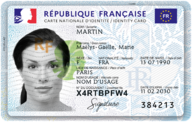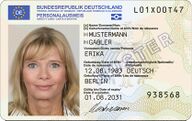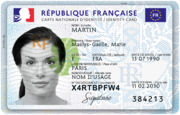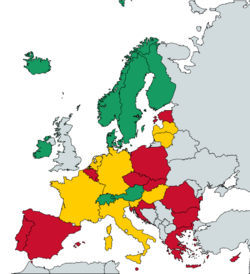European identity card
| European identity card | |
|---|---|
  Examples of the new common design. | |
| Type | Electronic identity card |
| Issued by | |
| First issued | 2 August 2021 |
| Purpose | Access to unified identity document in any of the EEA member states |
| Valid in |
|
| European Union regulation | |
| Text with EEA relevance | |
 | |
| Title | Regulation (EU) 2019/1157 of the European Parliament and of the Council of 20 June 2019 on strengthening the security of identity cards of Union citizens and of residence documents issued to Union citizens and their family members exercising their right of free movement |
|---|---|
| Made by | European Parliament and Council |
| Made under | Art. 21(2) TFEU |
| Journal reference | L 188, pp. 67–78 |
| History | |
| Date made | 20 June 2019 |
| Came into force | 10 July 2019 |
| Applies from | 2 August 2021 |
| Preparative texts | |
| Commission proposal | 17 April 2018 |
| Current legislation | |
The European identity card[1][2] is a common format of electronic identity document intended to replace and harmonise the various identity card models currently in use across the European Union (EU) and the European Economic Area (EEA).[lower-alpha 1] In accordance with its own laws, any Member State of the Union shall issue an identity card complying with the requirements of Regulation (EU) 2019/1157 of the European Parliament and of the Council of 20 June 2019 on strengthening the security of identity cards of Union citizens and of residence documents issued to Union citizens and their family members exercising their right of free movement, which is scheduled to enter into force on 2 August 2021.[4][5]
Identity cards not meeting the new requirements shall cease to be valid at their expiry or by 3 August 2031, whichever comes sooner. Identity cards which do not meet the minimum security standards or which do not include a functional machine-readable zone shall cease to be valid by 3 August 2026. Identity cards of persons aged 70 and above on 2 August 2021 which meet the minimum security standards and which have a functional MRZ shall cease to be valid at their expiry.[6]
Implementation throughout the member states is ongoing with various timetables on a per-country basis. Cyprus began issuing identity cards conforming to the harmonised requirements as early as August 2020, becoming the first country to implement the new standard.[7] It was followed by Malta the same month.[8][9] France started pilot testing the new document in select departements in March 2021, with a wider, progressive rollout planned for the following months.[10]
Use
Travel document
As an alternative to presenting a passport, EEA and Swiss citizens are entitled to use a valid national identity card as a stand-alone travel document to exercise their right of free movement in the European Economic Area and Switzerland.[11][12][13] The United Kingdom will accept these documents until 30 September 2021 for tourism and until at least 31 December 2025 for specific reasons.[14]
Strictly speaking, it is not necessary for an EEA or Swiss citizen to possess a valid national identity card or passport to enter the EEA and Switzerland. In theory, if an EEA or Swiss citizen can prove their nationality by any other means (e.g. by presenting an expired national identity card or passport, or a citizenship certificate), they must be permitted to enter the EEA and Switzerland. An EEA or Swiss citizen who is unable to demonstrate their nationality satisfactorily must, nonetheless, be given 'every reasonable opportunity' to obtain the necessary documents or to have them delivered within a reasonable period of time.[15][16][17][18][19]
Identification document
There are varying rules on domestic usage of identity documents. Some countries demand the usage of the national identity card or a passport. In other countries, e.g. Austria, Finland and Sweden, national identity cards are fully voluntary and not needed by everyone, as identity documents like driving licences are accepted domestically.
Common design and security features
Articles 3/4/5 of Regulation (EU) 2019/1157 state that:[6]
- Identity cards shall be in ID-1 format and shall contain a machine-readable zone (MRZ).
- Security standards shall be based on ICAO Document 9303.
- The document shall bear the title ‘Identity card’ or another well-established national designation in the official language, and the title ‘Identity card’ in at least one other official language of the institutions of the Union.
- The front side shall contain the two-letter country code of the Member State issuing the card printed in negative in a blue rectangle and encircled by 12 yellow stars.
- It shall include a highly secure storage medium which shall contain a facial image of the holder of the card and two fingerprints in interoperable digital formats. The storage medium shall have sufficient capacity and capability to guarantee the integrity, the authenticity and the confidentiality of the data. The data stored shall be accessible in contactless form and secured as provided for in Implementing Decision C(2018) 7767.
- Identity cards shall have a minimum period of validity of 5 years and a maximum period of validity of 10 years. But Member States may provide for a period of validity of less than 5 years for minors and more than 10 years for persons aged 70 and above.
Overview of national identity cards
Member-states are responsible for issuing national identity cards that meet the technical requirements of Regulation (EU) 2019/1157, in accordance with their own issuing procedures and requirements.
| Member state | Front | Reverse | Compulsory/ optional | Cost | Validity | Issuing authority | Latest version |
|---|---|---|---|---|---|---|---|
Cyprus |
Link to image | Link to image | Compulsory for Cypriot citizens aged 12 or over |
|
|
12 August 2020 | |

|

|
Identity documentation is legally optional[20] but the police have extensive powers to check a person's identity in many situations, up to 4-hour detention to make the necessary verification and take a photograph.[21] |
|
|
|
15 March 2021 | |

|

|
Optional; however, a national identity card or passport is compulsory for German citizens aged 16 or over, and valid identity documentation is compulsory for other EEA citizens |
|
|
|
From 2 August 2021 | |
| ´ | National identity card compulsory for Maltese citizens aged 18 or over |
|
|
|
August 2020[8][9] |
See also
- National identity cards in the European Economic Area
- Identity document
- European Health Insurance Card
- European driving licence
Notes
- ↑ 1.0 1.1 The legal acquis has been identified as EEA-relevant by the EU Commission, which makes it under scrutiny for incorporation into the EEA Agreement by Iceland, Liechtenstein and Norway . However, the legal basis rely on Article 21 of the Treaty on the Functioning of the European Union, an article which is not reflected in the EEA Agreement.[3]
References
- ↑ "The legal and political context for setting up a European identity document" (PDF). 2016. https://www.europarl.europa.eu/RegData/etudes/STUD/2016/556957/IPOL_STU(2016)556957_EN.pdf.
- ↑ "Proposal for a REGULATION OF THE EUROPEAN PARLIAMENT AND OF THE COUNCIL on strengthening the security of identity cards of Union citizens and of residence documents issued to Union citizens and their family members exercising their right of free movement" (PDF). 2018. https://ec.europa.eu/transparency/regdoc/rep/10102/2018/EN/SWD-2018-110-F1-EN-MAIN-PART-1.PDF.
- ↑ "Fri bevegelse av personer: styrket sikkerhet av ID-kort og oppholdsdokumenter | europalov". https://europalov.no/rettsakt/fri-bevegelse-av-personer-styrket-sikkerhet-av-id-kort-oppholdsdokumenter/id-25563.
- ↑ "Regulation (EU) 2019/1157 of the European Parliament and of the Council of 20 June 2019 on strengthening the security of identity cards of Union citizens and of residence documents issued to Union citizens and their family members exercising their right of free movement". https://www.efta.int/eea-lex/32019R1157.
- ↑ "Improving security for EU ID cards" (in en) (PDF). 2020. https://what-europe-does-for-me.eu/data/pdf/social/X07_31801_en.pdf.
- ↑ 6.0 6.1 "EUR-Lex - 32019R1157 - EN - EUR-Lex" (in en). https://eur-lex.europa.eu/eli/reg/2019/1157/oj.
- ↑ Chrysostomou, Annette. "New type of ID cards now being issued | Cyprus Mail" (in en-GB). https://cyprus-mail.com/2020/08/17/new-type-of-id-cards-now-being-issued/.
- ↑ 8.0 8.1 Schmeh, Klaus (2020-10-13). "Republic of Malta launches electronic identity card" (in en-US). https://www.cryptovision.com/en/republic-of-malta-launches-electronic-identity-card/.
- ↑ 9.0 9.1 "New Maltese ID Card will enter circulation later this month | Identity Malta Agency" (in en-US). 2020-08-28. https://identitymalta.com/new-maltese-id-card-will-enter-circulation-later-this-month/.
- ↑ Wesfreid, Marcelo (2021-03-15). "Puce infalsifiable, QR code... Marlène Schiappa présente la nouvelle carte d’identité numérique" (in fr-FR). https://www.leparisien.fr/politique/puce-infalsifiable-qr-code-marlene-schiappa-presente-la-nouvelle-carte-d-identite-numerique-15-03-2021-8428661.php.
- ↑ Articles 4 and 5 of the Citizens’ Rights Directive 2004/38/EC (L 158, pp. 77–123)
- ↑ "APPENDIX 1 Movement of persons (Art. 20)". Article 1. https://www.efta.int/sites/default/files/documents/legal-texts/efta-convention/annexes/Annex%20K%20Persons%20Appendix%20I%20Movement%208980.pdf.
- ↑ "EUR-Lex - 22002A0430(01) - EN" (in EN). 30 April 2002. pp. 0006–0072. https://eur-lex.europa.eu/LexUriServ/LexUriServ.do?uri=CELEX:22002A0430(01):EN:HTML.
- ↑ "Visiting the UK: information for EU, EEA and Swiss citizens" (in en). https://www.gov.uk/guidance/visiting-the-uk-after-brexit.
- ↑ Article 5(4) of the Citizens’ Rights Directive 2004/38/EC (L 158, pp. 77–123)
- ↑ Practical Handbook for Border Guards, Part II, section I, point 2.9 (C (2019) 7131)
- ↑ Judgment of the European Court of Justice of 17 February 2005, Case C 215/03, Salah Oulane vs. Minister voor Vreemdelingenzaken en Integratie
- ↑ Regulation 11 of the Immigration (European Economic Area) Regulations 2016
- ↑ "Processing British and EEA Passengers without a valid Passport or Travel Document". http://www.ukba.homeoffice.gov.uk/sitecontent/documents/policyandlaw/borderforce/primary-checkpoint/initial-examination/uk-eea-no-passport.pdf.
- ↑ "Est-il obligatoire d'avoir une carte d'identité ?" (in Fr). https://www.service-public.fr/particuliers/vosdroits/F11601.
- ↑ "Contrôle d'identité" (in Fr). https://www.service-public.fr/particuliers/vosdroits/F1036.
- ↑ https://www.interieur.gouv.fr/Actualites/L-actu-du-Ministere/La-nouvelle-carte-nationale-d-identite
- ↑ "E-ID Cards Unit | Identity Malta Agency" (in en-US). 2019-10-08. https://identitymalta.com/unit/e-id-cards-unit/.
External links
| Wikimedia Commons has media related to European identity card. |
- Regulation (EU) 2019/1157 of the European Parliament and of the Council of 20 June 2019 on strengthening the security of identity cards of Union citizens and of residence documents issued to Union citizens and their family members exercising their right of free movement
- National identity cards in PRADO (The Council of the European Union Public Register of Authentic Travel and Identity Documents Online)


